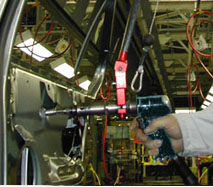
As repetitive strain injuries, like carpal tunnel syndrome, continue to increase in the assembly workplace, awareness of ergonomic solutions should be on the radar for many companies. If not, the cost for workers’ compensation claims will become a costly and growing issue.
According to OSHA, “repetitive stress injuries (RSI), comprise more than one hundred different types of job-induced injuries and illnesses resulting from wear and tear on the body. RSIs are one of the fastest growing workplace injuries, and can result any time there is a mismatch between the physical requirements of the job and the physical capacity of the human body. Specific risk factors that can cause RSIs include repetitive motion, force, awkward posture, heavy lifting, or a combination of these factors”.
What is Ergonomics?
“The scientific discipline concerned with understanding of interactions among humans and other elements of a system, and the profession that applies theory, principles, methods and data to design in order to optimize human well-being and overall system performance”.
Ergonomics means
“fitting the job to the worker”
From the Greek Words
Ergo = Work
Nomos = Laws
Source : International Ergonomics Association (IEA) in 2000
Risk of injury for the assembly operator depends on the duration, frequency or intensity of exposure to the assembly job function. Assembly operators often can spend long periods standing and/or performing repetitive motions with torque tools over the course of their shift. Ergonomic solutions can considerably reduce the physical impact of these daily industrial tasks. Assembling mechanical and electronic components demands efficiency, space, productivity and ergonomics.
Managers and companies need to get involved in ergonomics. Recognize and report any signs and symptoms. Look to get involved and come up with ergonomic assembly solutions. Early prevention saves time and unnecessary costs.
A successful ergonomic system incorporates employee participation that includes discussion across all levels and directions of an organization. It’s recommended to avoid the one-size-fits-all approach. Every ergonomic concern requires its own evaluation, ideally performed by a person competent in such issues. When indicated, control measures should be designed to eliminate ergonomic stresses specific to the results of the evaluation. Finally, effective follow-up mechanisms must be provided.
– Form a permanent safety committee
– Perform a job safety analysis for every job
– Perform routine inspections, even if no hazards have been reported
– Immediately correct any deficiencies; and conduct an accident investigation for each incident, even “near misses.”
When planning a production area, it pays dividends for manufacturers in the long term to plan the ergonomics of the operation and consult a health and safety inspector or ergonomic manager. Ensuring both the workplace and the assembly operation are compatible with the majority of operators that handle the assembly tools, reduces future costs arising from work-related health disorders among operators, along with costs arising from poor product quality.
Some key questions manufacturers need to ask about their production area.
– How often do your assemblers complain of fatigue or arm pains?
– How much does a typical injury cost the organization?
– How many workman comp claims have you had?
– How often does a health and safety inspector review your applications?
– What ergonomic solutions are being considered for that application?
Torque arms are one ergonomic solution available for the assembly area. The tools are designed to reduce RMI (repetitive motion injury) and CTS (carpal tunnel syndrome). A torque arm eliminates the torque reaction of power and pneumatic tools. Selecting the right torque tool for the assembly process is not the only element to consider when setting up a workstation. Operator safety is a key item to evaluate as well. The goal must be to protect the operator from any potential injury and make them feel comfortable and secure in operating a tool.
Effortless handling of the assembly tool with a torque arm helps increase production as well, due to easier, more precise tool operation. The EZ-Glider torque arms are designed to improve production and quality control during the assembly process, plus provide ergonomic safety for any operator. Mountz offers a variety of torque arm options to meet the various assembly applications and requirements.
The linear torque arm provides fluid movement and absorbs torque reaction from electric or pneumatic screwdrivers. Articulated torque arms, with the ability to bend like an elbow, provide flexible 360-degree range, allowing quick rundown of multiple fasteners. Telescoping torque arms, crafted with lightweight durable carbon fiber, collapse like a telescope to provide operators full flexibility on the assembly line. Position control torque arms help manufacturers detect and eliminate costly screw-fastening errors during the assembly process.
Using an ergonomic torque arm makes a safer world through accuracy and precision. Need assistance with selecting the proper ergonomic torque arm solution? We are happy to help, contact us. You can also request an appointment for a Mountz representative to visit your facility and provide a product demonstration.